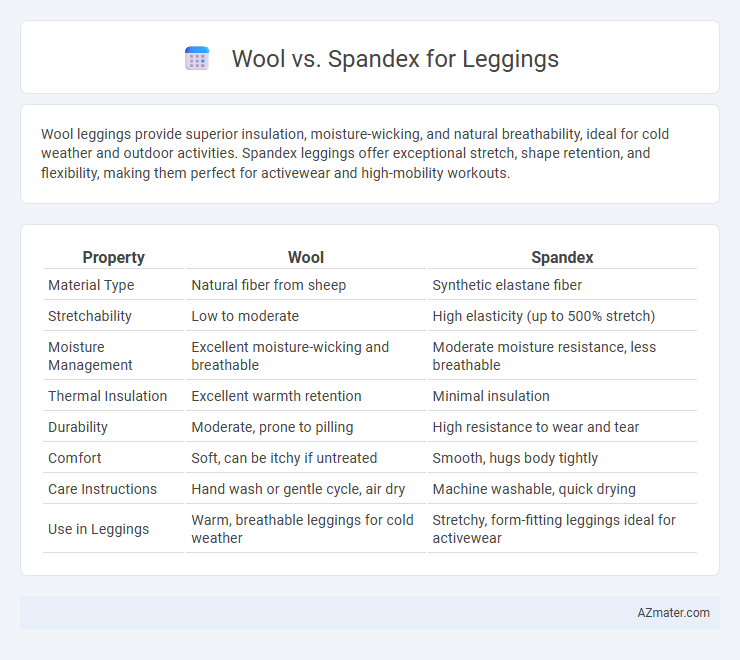Wool leggings provide superior insulation, moisture-wicking, and natural breathability, ideal for cold weather and outdoor activities. Spandex leggings offer exceptional stretch, shape retention, and flexibility, making them perfect for activewear and high-mobility workouts.
Table of Comparison
| Property | Wool | Spandex |
|---|---|---|
| Material Type | Natural fiber from sheep | Synthetic elastane fiber |
| Stretchability | Low to moderate | High elasticity (up to 500% stretch) |
| Moisture Management | Excellent moisture-wicking and breathable | Moderate moisture resistance, less breathable |
| Thermal Insulation | Excellent warmth retention | Minimal insulation |
| Durability | Moderate, prone to pilling | High resistance to wear and tear |
| Comfort | Soft, can be itchy if untreated | Smooth, hugs body tightly |
| Care Instructions | Hand wash or gentle cycle, air dry | Machine washable, quick drying |
| Use in Leggings | Warm, breathable leggings for cold weather | Stretchy, form-fitting leggings ideal for activewear |
Introduction: Wool vs Spandex Leggings
Wool leggings offer natural insulation, moisture-wicking properties, and breathability, making them ideal for cold weather and outdoor activities. Spandex leggings provide superior stretch, shape retention, and a snug fit, enhancing comfort and flexibility during workouts and daily wear. Choosing between wool and spandex depends on prioritizing warmth and natural fibers versus durability and elasticity for active use.
Material Overview: What is Wool?
Wool is a natural fiber obtained from the fleece of sheep, prized for its excellent insulation and moisture-wicking properties, making it ideal for leggings worn in cooler climates. Its breathable and odor-resistant qualities provide superior comfort during physical activities compared to synthetic fibers like spandex. Wool's elasticity allows for moderate stretch, but it is often blended with spandex to enhance flexibility and fit in legging design.
Material Overview: What is Spandex?
Spandex, also known as elastane or Lycra, is a synthetic fiber renowned for its exceptional elasticity, commonly used in leggings to provide stretch and shape retention. Unlike wool, which is a natural fiber derived from sheep, spandex is made from a long-chain polymer called polyurethane, offering superior flexibility and durability. Its moisture-wicking properties and resistance to abrasion make spandex ideal for activewear, enhancing comfort and performance in leggings.
Comfort and Wearability Comparison
Wool leggings provide superior breathability and natural moisture-wicking properties, ensuring comfort during extended wear in cooler conditions. Spandex-based leggings offer excellent stretch and shape retention, enhancing mobility and fit for active use. Combining wool's insulation with spandex's elasticity creates durable, comfortable leggings ideal for varied activities and temperatures.
Breathability and Moisture Management
Wool leggings excel in breathability due to their natural fibers, allowing air circulation and effective moisture-wicking to keep skin dry during workouts. Spandex, while stretchy and form-fitting, offers limited breathability and tends to trap heat and sweat, potentially leading to discomfort. Combining wool with spandex blends enhances moisture management by blending natural ventilation with flexible fit, ideal for activewear.
Warmth and Insulation Qualities
Wool leggings provide superior warmth and natural insulation due to lanolin, which repels moisture and retains heat even when damp. Spandex leggings offer minimal insulation but excel in flexibility and moisture-wicking, making them less effective for cold weather. Combining wool with a small percentage of spandex creates leggings that balance warmth with stretch and comfort.
Stretch and Flexibility Factors
Wool leggings offer moderate stretch and natural breathability, providing warmth while maintaining shape through resilience in fibers like merino wool. Spandex enhances flexibility significantly, with up to 500% stretch capacity, allowing leggings to contour tightly to the body without restricting movement. Combining wool with spandex creates leggings that balance thermal insulation and superior elasticity, ideal for activewear requiring both comfort and dynamic flexibility.
Durability and Longevity
Wool leggings offer exceptional durability due to the natural resilience and moisture-wicking properties of merino fibers, which resist pilling and retain shape over time. Spandex, known for its superior elasticity and stretch retention, enhances fit and movement but may degrade faster with frequent washing and heat exposure. Combining wool with spandex blends optimizes longevity by balancing toughness with flexibility, ideal for leggings designed for both activewear and long-term use.
Eco-Friendliness and Sustainability
Wool offers superior eco-friendliness due to its natural biodegradability and renewable sourcing, making it a sustainable choice for leggings. Spandex, a synthetic fiber derived from petrochemicals, poses environmental challenges in production and disposal, often contributing to microplastic pollution. Choosing wool-based leggings supports reduced environmental impact and promotes sustainable fashion.
Choosing the Best Legging Material: Wool or Spandex?
Wool offers superior insulation and moisture-wicking properties, making it ideal for cold-weather leggings with natural breathability and odor resistance. Spandex, known for its exceptional stretch and shape retention, provides maximum flexibility and comfort during high-intensity workouts. Choosing between wool and spandex depends on activity type and climate, with wool excelling in warmth and spandex in mobility and fit.

Infographic: Wool vs Spandex for Legging
 azmater.com
azmater.com